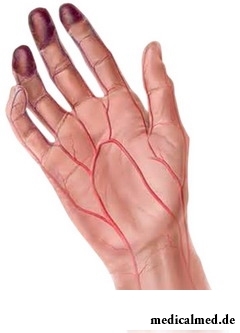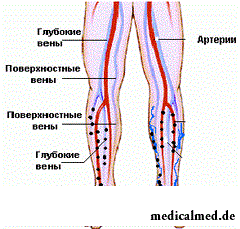





Thrombangiitis obliterans
The Thrombangiitis obliterans  represents an obliterating thromboangitis - narrowing of veins and arteries of the average and small sizes in upper and lower extremities as a result of inflammatory process. In rare instances pathology is shown in coronary, cerebral and visceral arteries.
represents an obliterating thromboangitis - narrowing of veins and arteries of the average and small sizes in upper and lower extremities as a result of inflammatory process. In rare instances pathology is shown in coronary, cerebral and visceral arteries.
The disease was described by the German doctor Leo Byurger in 1908 who stated a hypothesis that this disease became the reason of 11 amputations of extremities which are carried out by him.
Traditionally it is considered that Thrombangiitis obliterans are subject, the men generally smoking aged from 20-40 years. However cases of diagnosing of a disease at women became frequent in recent years that has a talk with distribution of smoking among women.
Despite assumptions of specialists, the disease etiology is up to the end not found out: there are instructions concerning influence on an organism of patients of hereditary factors, in particular, of a carriage of HLA antigens - B5 and A9, and also existence for the sick antibodies directed against laminin, elastin and collagen I, III and IV of types.
Clinical picture of a Thrombangiitis obliterans
Pathomorphologically gradual decrease in blood circulation of hands or legs is observed, since distal departments (finger-tips) and extending proksimalno (up). Inflammations of arteries are characterized by cellular and infiltrative processes in all three layers of a vascular wall: defeat of an intima, splitting of cellular membranes, a hyperplasia of an endothelium and the expressed thrombosis.
Distinguish two main forms of defeat: peripheral and mixed. At the first form of a Thrombangiitis obliterans vessels or the main arteries of extremities with characteristic symptoms of arterial ischemia of legs, the migrating thrombophlebitis, a Crocq's disease, formation of ulcers are surprised. At the mixed form along with signs of defeat of vessels of extremities symptoms of damage of heart, vessels of a brain, kidneys, changes in lungs, abdominal symptomatology are observed.
During an initial stage of a Thrombangiitis obliterans functional changes in extremities are observed: chill of legs, feeling of numbness, feeling of "goosebumps". Patients note an anesthesia of fingers, a posineniye and pain. At defeat of vessels of legs the symptom of the alternating lameness - sharp painful feelings in gastrocnemius muscles appears during walking.
Against the background of a course of a disease of the Burgher trophic frustration can be observed: hyperhidrosis, anhidrosis, hyperpegmentation, hypostases, atrophy of skin, muscles, necroses, trophic ulcers, gangrene.
Diagnosis of a Thrombangiitis obliterans
Often diagnosis of a Thrombangiitis obliterans has the excluding character (in cases when the impossibility of existence of other diseases at above-mentioned symptoms is proved). The diagnosis of an obliterating thromboangitis can be made with the following aspects:
- The age of the patient is younger than 40-45 years;
- The existence of signs of insufficient blood circulation in tissues of extremities with pains, lameness, ulcers revealed by means of noninvasive methods of a research (for example, ultrasonography with effect of a dopler);
- Exception of the diseases connected with disturbance of coagulability of blood, autoimmune diseases, a diabetes mellitus;
- Pathological processes of similar character come to light both in the patient, and in the seeming healthy extremity.
Apply the following to functional trials which would demonstrate disturbances of blood supply of extremities:
- Symptom of plantar ischemia of Oppel (blanching of the affected extremity raised up);
- Goldflam's test (the patient in a dorsal decubitus carries out exercises on bending and extension of knee and coxofemoral joints. At the expressed blood circulation disturbance the patient feels fatigue after 10 manipulations);
- Knee phenomenon of Panchenko (the patient in a sitting position, having thrown back a sore leg on healthy, begins to feel feelings of numbness, pain in the affected extremity).
Treatment of a Thrombangiitis obliterans
Now effective methods of treatment of a Thrombangiitis obliterans do not exist. At early stages of an obliterating  thromboangitis specialists recommend to perform the conservative treatment connected with:
thromboangitis specialists recommend to perform the conservative treatment connected with:
- Elimination of impact on a disease of etiological factors (in particular, smoking cessation);
- Removal of pains;
- Elimination of a vasospasm by means of ganglioblokator and spasmolysants;
- Normalization of processes of coagulability of blood, improvement of its rheological properties;
- Improvement of metabolic processes in fabrics.
In case of lack of positive effect from conservative therapy there are premises to performing surgery. For the purpose of a spasmolysis of peripheral arteries surgeons carry out a lumbar sympathectomy. In case of involvement in pathological process of vessels of upper extremities the chest sympathectomy is carried out. There is also information on positive impact on disease of the Burgher of hyperbaric oxygenation and a plasma exchange, however, these methods standard are not.
Efficiency of an alternative technique of treatment of the Thrombangiitis obliterans passing clinical tests - injections of stem cells - is still not confirmed officially.
Emergence of necroses and gangrene on the affected extremities is the indication to amputation. Statistically, about 35% of the patients having this diagnosis are not possible to avoid surgical removal of extremities.
Recommendations
The person suffering from a Thrombangiitis obliterans has to leave off smoking immediately - otherwise the disease will only progress. Besides, the patient should avoid injuries of skin because of influence of the high or low temperatures, chemicals, defeats connected with wearing inconvenient footwear, carrying out small operations (for example, removal of a callosity), fungal infections.
Short walking (20-30 minutes) several times a day is recommended to all patients (except patients with existence of ulcers and gangrenes on the affected extremities).
The educated person is less subject to brain diseases. Intellectual activity promotes formation of the additional fabric compensating sick.

The unpleasant feelings connected with spring breakdown are familiar almost to each of us. Often happens that in March-April on the person...
Section: Articles about health
Eyes – one of the most vulnerable areas on a face therefore age changes concern them first of all. Whether it is possible to keep look youth for many years and what procedures are offered for achievement of this purpose by cosmetologists? And maybe, only thing of a vari...
Section: Articles about health
There is a lot of fans of beer in our country. Statistically, on each average Russian (including women and children) in a year about 60 liters of this drink are consumed. It is not a lot of, as in the Czech Republic or Germany, but figure all the same impressive. There is nothing to rejoice here: despite assurances of producers that beer is absolutely harmless, effects of its active consumption cannot be considered positive in any way. Here only part of that negative impact, which popular нап...
Section: Articles about health
Statistically, in Russia about 34% of citizens smoke. Most of consumers of tobacco has problems about health sooner or later...
Section: Articles about health
Run - one of the most available and effective ways to revitalize the organism. Knowing about its extraordinary advantage, each of us at least once tried to make jogs, but only the few made these occupations regular. In spite of the fact that in jogging (easy an ozdor...
Section: Articles about health
Each failure in work of bodies and systems of a human body is, as a rule, shown by the whole complex of symptoms. In particular, malfunctions with health often cause emergence of cosmetic defects in the form of rashes on a face. Experienced doctors know that localization of heat-spots usually depends on what disease the patient has....
Section: Articles about health
In consciousness of our many compatriots idea that folk remedies if no more эфф strongly took roots...
Section: Articles about health
The immunity role in growth of the child is invaluable. The proteins-immunoglobulins produced by immune system preserve the child against the diseases capable − owing to an organism weak still − to serve as a stressful factor, to become the reason of many complications and delays in unless...
Section: Articles about health
During foot walks blood moves on vessels more actively and one and all bodies are supplied with a large amount of oxygen. It affects the state of health of the person very positively....
Section: Slideshow
There is an opinion that at low temperatures safety of products is ensured longer and better thanks to what the refrigerator considers...
Section: Articles about health
The next flu epidemic leads to the next panic, from year to year we give in on these manipulations: professionally alarming voice of the announcer in news, reports with calculation of the died patients, an interview with people in white dressing gowns and advertizing of anti-influenza means ра...
Section: Articles about health
Striya (extension) are the defects of skin having an appearance of direct or wavy strips from 1 to 10 cm long and 1-5 mm wide. In most cases at women of a striya are located on a stomach, hips, a breast or buttocks. At athletes they can appear on shoulders and the internal surface of forearms. At initial stages of development of an extension have red or lilac color, but over time their coloring turns pale, and strips become whitish, getting a nacreous shade....
Section: Articles about health
The healthy nutrition is the invariable principle of health and good health for long years of the woman. Nevertheless, in a diet at each stage of life there are the features allowing to support an organism by those substances which are most necessary for it at present. Eating according to them, the woman will be able to feel vigorous and strong, and also to adapt to changes in an organism so that they allowed it to lead active lifestyle at any age....
Section: Articles about health
Food with the increased content of sugar is attractive to most of people - it is scientifically confirmed fact. Business here not in a nevozder...
Section: Articles about health
Each person supports all life a SARS about 200 times. The peak of incidence falls on cold season, but it is possible to get sick with a temperature and a pharyngalgia, and sometimes and very possibly, even during a heat. The reasons for development of catarrhal diseases exists множество:...
Section: Articles about health
Milk and products of its processing by right occupy one of the main places in a diet of the modern person. They contain proteins, necessary for normal life activity, fats, vitamins and microelements, and are an important part of various medical diets....
Section: Articles about health
Life activity of one-celled fungi of the sort Candida is a proximate cause of development of candidiasis (milkwoman), it is related...
Section: Articles about health
Statistically, can only one of ten of our compatriots brag of a decent condition of an oral cavity. Six teeth affected with caries are the share of the average Russian. For comparison, this indicator for Europeans almost six times exchanges...
Section: Articles about health
Work of a brain is extremely complex and in many respects is not studied yet. It is confirmed also by the features of thought processes which are shown when the person sleeps. Let's tell about some of them....
Section: Articles about health
Dark circles (bruises) under eyes – a shortcoming with most of which often fight against the help of cosmetics (proofreaders, salons...
Section: Articles about health
Within several decades of our compatriots convinced that the use of butter nasty affects a condition of coronary vessels. As a result the reputation of a product was impaired thoroughly a little, and many almost ceased to include...
Section: Articles about health
Not everyone can brag of the shining Hollywood smile. Even the person who is regularly visiting the stomatologist and watching of oral cavities over health periodically has problems: enamel of teeth darkens under the influence of some products, on it the deposits giving to teeth a grayish or yellowish shade collect....
Section: Articles about health
The kid who was recently born is surrounded with love of adult family members and their cares without which the baby cannot exist....
Section: Articles about health
Deciding to get rid of an addiction, not all imagine what effects it is necessary to face. Process of refusal of smoking causes quite essential discomfort in most of people: differences of mood, sleep disorder, fatigue, decrease физич...
Section: Articles about health
Hemorrhoids – extremely widespread disease. Periodically arising inflammations and bleeding of hemorrhoidal nodes cause serious discomfort to nearly fifteen percent of adults. Meanwhile, having a clear idea of the reasons of an exacerbation of an illness and following rules of precaution, it is possible to reduce substantially sharpness of unpleasant feelings and to reduce progressing of a disease....
Section: Articles about health


